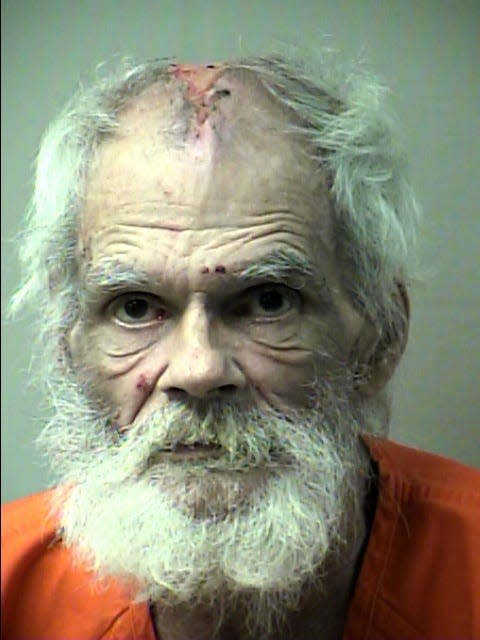24 years later, DNA leads to arrest in Okaloosa County rape case
Thanks to a new DNA search, the Okaloosa County Sheriff’s Office has arrested a man on sexual battery charges − 24 years after a woman reported being raped.
Charles Louis Craig, 60, was arrested in California and has been extradited to Florida. The story unfolded only after several twists and turns, and even now, investigators are not releasing many of the details.
The woman, whose name is not being published to protect her privacy, said she left a bar in Mary Esther, Florida in March 1999 when she was approached by a man with brown hair, brown eyes and a mustache. He identified himself as “Ron” and offered her a ride in his white, compact car, according to the sheriff's office.
Panama City visit: Citing privacy concerns, Gov. Ron DeSantis opposes any U.S. Central Bank digital currency
High school sports: NWF Daily News Softball Power Ranks and Stat Leaders on Emerald Coast
He drove her to an area of Sunset Lane in the Poquito Bayou neighborhood of Shalimar. When she refused to remove her clothes, he grabbed her by the throat and threatened to break her neck if she did not comply, the sheriff's office said. He dropped her off at State Road 189 and State Road 85. A passerby picked her up and took her to the Niceville Police Department.
She underwent a Florida Department of Law Enforcement sexual assault examination. Then…nothing.
Investigators now know that Craig had already served a prison sentence on drug charges out of Okaloosa County under the alias of Ron Grisby. In fact, he had just been released the month before when he allegedly assaulted his rape victim. He listed his address as Destin.
He lived in several different states over the years.
A break in the case
In February 2020, the FDLE sexual assault kit was sent to FDLE for a new review, according to the most recent arrest warrant. But this was not a case of a rape kit sitting on a shelf for years without being tested - a national crime lab scandal that embarrassed law enforcement agencies and outraged victims until the problem was resolved a few years ago.
“The profile was entered into CODIS,” investigators noted.
CODIS is an acronym for Combined DNA Index System, which is a computer software program that operates local, state and national databases of DNA profiles from convicted offenders, unsolved crime scene evidence, and missing persons.

“In July of 2020, a secondary FDLE report was received regarding a CODIS match to the profile noted above. The matching male contributor was identified as the Defendant, Charles L. Craig utilizing his FBI identification number,” the arrest report states.
Advances in DNA evidence
“In recent years, there have been numerous advances with regard to DNA evidence,” Okaloosa investigators said in a response to emailed questions about the case.
Scientists have been “adopting new techniques in molecular biology and bioinformatics to analyze and identify samples once believed too scarce, too dirty, or too damaged to be useful,” according to a recent article in Genetic engineering and Biotechnology News. .
FDLE has long partnered with CODIS, but somehow, a hit on Craig’s DNA took years to develop.
“Through investigative efforts, investigators were able to determine a known alias of the suspect, which was similar to information provided by the victim in this case,” officials said.
The sheriff’s office declined to say what those “investigative efforts” were.
The arrest warrant noted that prior to his arrest, “extensive research has been conducted in an attempt to locate him to secure a new DNA sample to send to FDLE for comparison. The results of that research have been unsuccessful. Teletypes have been sent to several agencies requesting they check previous addresses, however he has not been located as of this time.”
The DNA database has exploded with names over the years. For example, in 1995, four years after an unidentified rape victim’s body was found in Lake County, an FDLE analyst in Orlando was feeding data from the case into the system. “When I fed the information into the computer, the guy in Tallahassee yelled,” David Baer recalled in an interview with the Orlando Sentinel.
It was the first time the FDLE computer spit out the name of a suspect, a convicted rapist. There were 10,000 entries in the computer. Now, Florida has one of the largest databases in the country, and it grows by leaps and bounds every year.
Unfortunately, “Jane Doe” has still not been identified. New techniques, including using public genealogy databases might someday reveal her name. That technique was what led investigators to “The Golden State Killer,” Joseph Deangelo, in 2018 after years of murdering and raping his victims.
As for Craig: It is unclear why he ended up in the Kern County, California jail, if he was under arrest or serving a sentence for a California crime, or if he was picked up on the Oklaloosa warrant.
A sheriff’s official in Bakersfield, California, said the information was not public since Craig was no longer held at that facility.
This article originally appeared on Northwest Florida Daily News: DNA breakthrough leads to arrest in 1999 rape case in Okaloosa County
